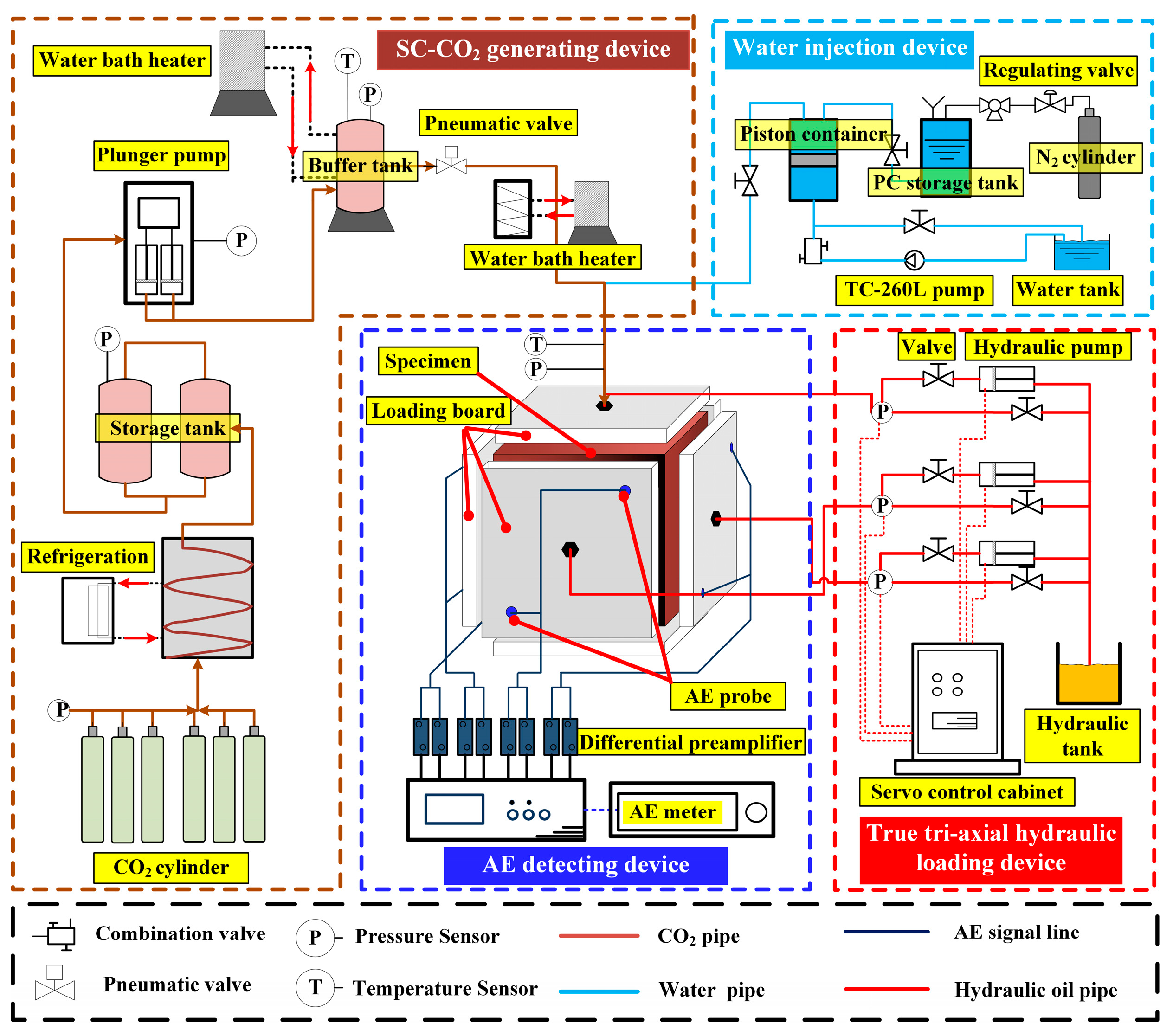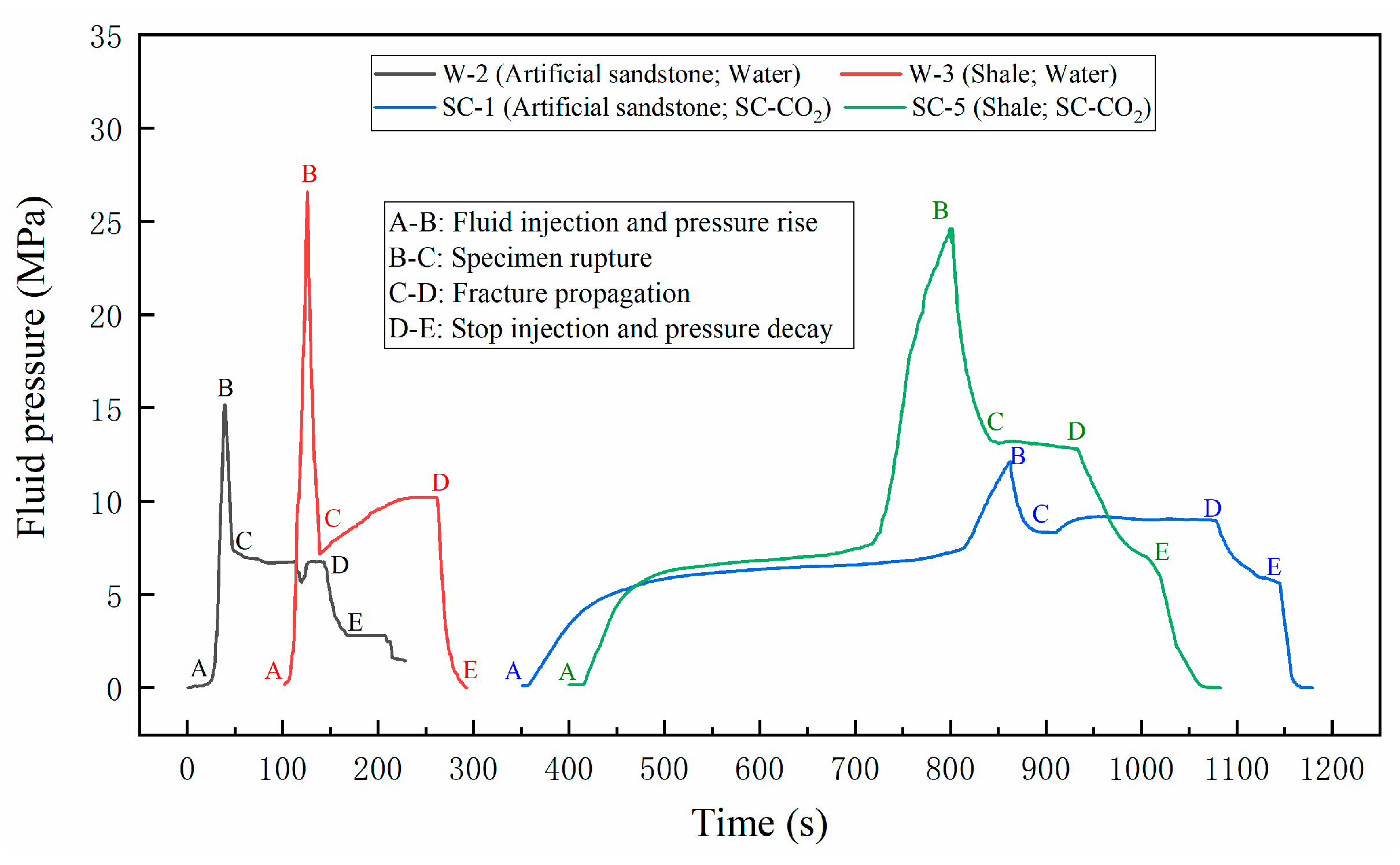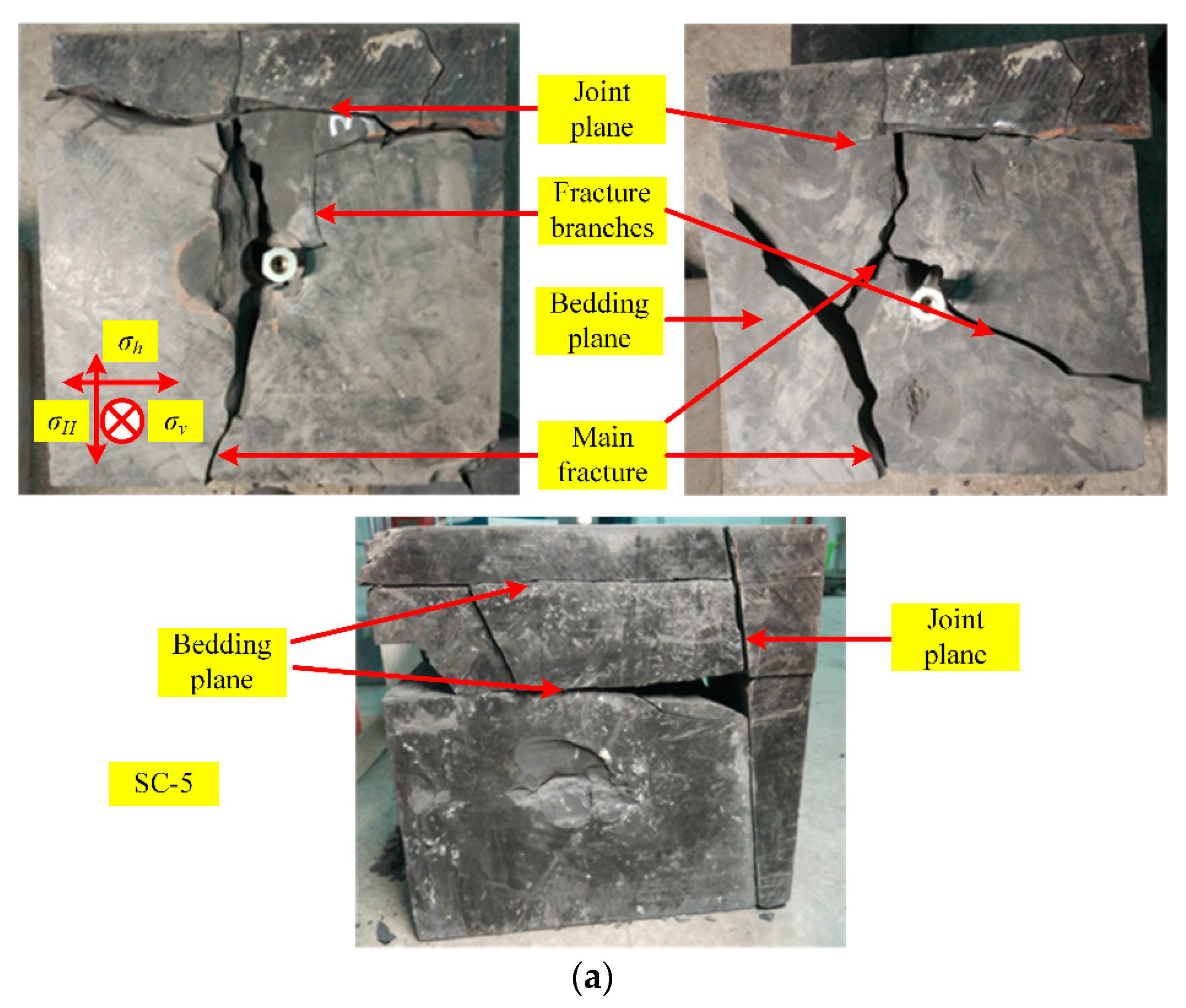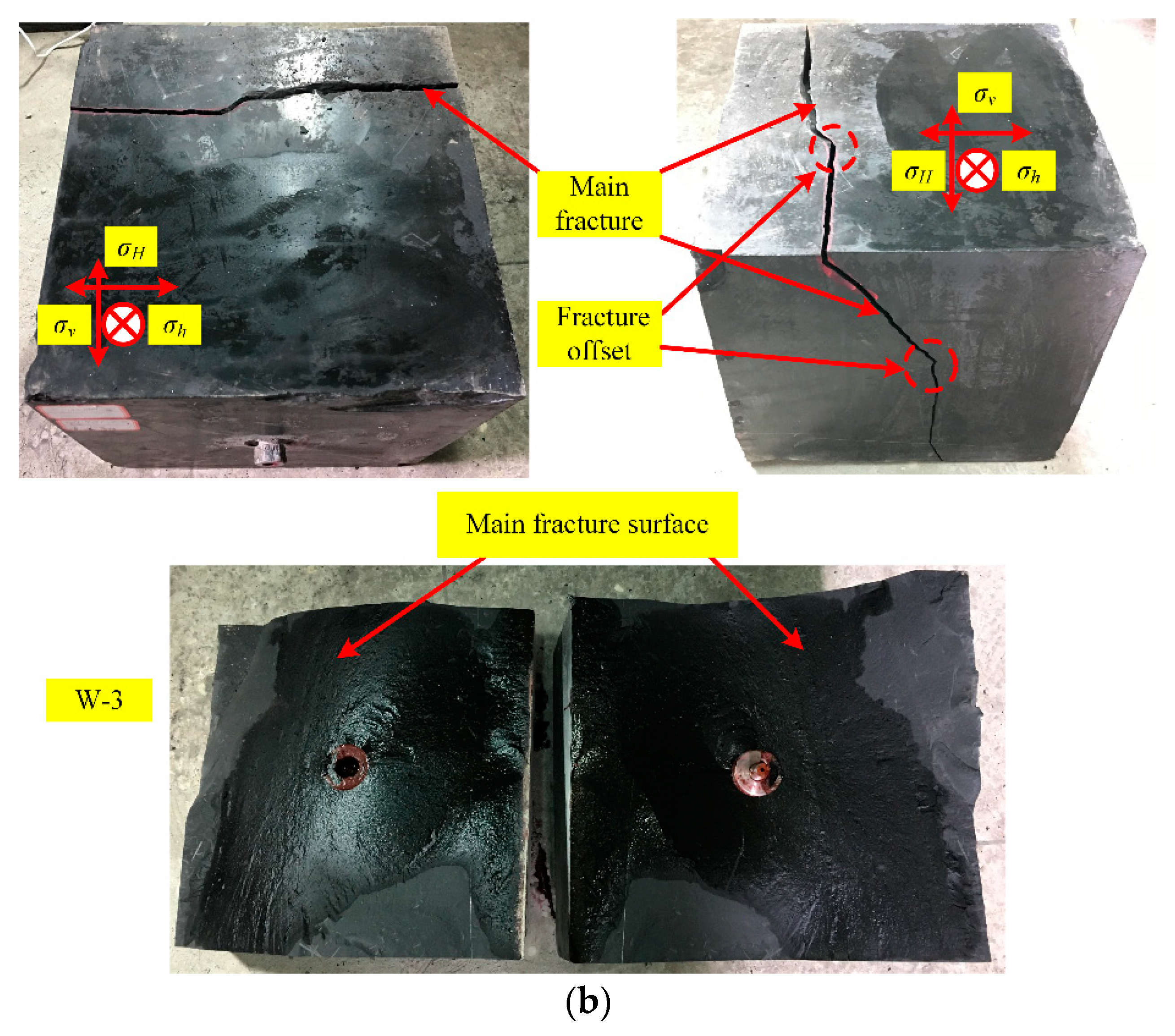Propagation Characteristics of Supercritical Carbon Dioxide Induced Fractures under True Tri-Axial Stresses
Abstract
1. Introduction
2. Experimental Methodologies
2.1. Experimental Apparatuses
2.2. Specimen Preparation
2.3. Experimental Procedure
3. Experimental Results and Discussion
3.1. Fluid Pressure During Fracturing
3.2. Comparison of Breakdown Pressure
3.3. Acoustic Emission Characteristics During Fracturing
3.4. Fracture Propagation and Morphology
4. Conclusions
- The fluid pressure–time curve of SC-CO2 fracturing is different from water fracturing. The pressure rise stage of SC-CO2 fracturing takes 7–9 min due to the complex phase transition process of CO2 in this stage, and the pressure rise stage of water fracturing only takes 1–2 min. At the specimen rupture stage and pressure decay stage, the pressure drop process of SC-CO2 is relatively flat compared with water fracturing due to the high compressibility of SC-CO2.
- Under the same in-situ stress condition, the breakdown pressure of SC-CO2 fracturing is about 10% lower than that of water fracturing no matter if using shale or artificial sandstone as fracturing materials, because the percolation effect of SC-CO2 can greatly increase pore pressure, which leads to the decrease in breakdown pressure.
- The AE energy surge phenomena mainly occur at the specimen rupture stage due to the severe rupture of the specimens. The AE energy release rate of SC-CO2 fracturing is 1–2 orders of magnitude higher than that of water fracturing, signifying that more energy can be converted into kinetic energy to promote fracture growth.
- By observing the fracture morphology in shale and artificial sandstone fracturing by SC-CO2 and water, the main fracture mainly propagates along the directions perpendicular to the minimum principal stress in artificial sandstone, which is homogeneous no matter if using SC-CO2 as fracturing fluid; but in shale, the weak structural plane and in-situ stresses compete for the dominance of the propagation direction of the fractures.
Author Contributions
Funding
Conflicts of Interest
References
- Wang, X.; Wang, T. The Shale Gas Potential of China. In SPE Production and Operations Symposium; Society of Petroleum Engineers: Oklahoma City, OK, USA, 2011; p. 7. [Google Scholar]
- Dong, D.; Guan, Q.; Wang, S.; Huang, J.; Wang, Y.; Zhang, C.J.E.E. Exploitation, Shale gas in China: Reality and dream. Energy Explor. Exploit. 2015, 33, 397–418. [Google Scholar] [CrossRef]
- Wang, Q.; Chen, X.; Jha, A.N.; Rogers, H. Natural gas from shale formation—The evolution, evidences and challenges of shale gas revolution in United States. Renew. Sustain. Energy Rev. 2014, 30, 1–28. [Google Scholar] [CrossRef]
- Fisher, M.K.; Warpinski, N.R. Hydraulic-Fracture-Height Growth: Real Data. SPE-145949-PA 2012, 27, 8–19. [Google Scholar] [CrossRef]
- Eberhardt, E.; Amini, A. Hydraulic Fracturing. In Encyclopedia of Engineering Geology; Bobrowsky, P.T., Marker, B., Eds.; Springer International Publishing: Cham, Switzerland, 2018; pp. 489–495. [Google Scholar]
- Liang, B.; Jiang, H.; Li, J.; Gong, C.; Jiang, R.; Pei, Y.; Wei, S. Flow in multi-scale discrete fracture networks with stress sensitivity. J. Nat. Gas Sci. Eng. 2016, 35, 851–859. [Google Scholar] [CrossRef]
- Scanlon, B.R.; Reedy, R.C.; Nicot, J.P. Comparison of water use for hydraulic fracturing for unconventional oil and gas versus conventional oil. Environ. Sci. Technol. 2014, 48, 12386–12393. [Google Scholar] [CrossRef] [PubMed]
- Hu, Y.; Kang, Y.; Wang, X.; Li, X.; Huang, M.; Zhang, M. Experimental and theoretical analysis of a supercritical carbon dioxide jet on wellbore temperature and pressure. J. Nat. Gas Sci. Eng. 2016, 36, 108–116. [Google Scholar] [CrossRef]
- Vengosh, A.; Warner, N.; Jackson, R.; Darrah, T. The Effects of Shale Gas Exploration and Hydraulic Fracturing on the Quality of Water Resources in the United States. Procedia Earth Planet. Sci. 2013, 7, 863–866. [Google Scholar] [CrossRef]
- Jackson, R.E.; Gorody, A.W.; Mayer, B.; Roy, J.W.; Ryan, M.C.; Van Stempvoort, D.R. Groundwater protection and unconventional gas extraction: The critical need for field-based hydrogeological research. Groundwater 2013, 51, 488–510. [Google Scholar] [CrossRef]
- Pearson, C. The relationship between microseismicity and high pore pressures during hydraulic stimulation experiments in low permeability granitic rocks. J. Geophys. Res. Solid Earth 1981, 86, 7855–7864. [Google Scholar] [CrossRef]
- Elsworth, D.; Spiers, C.J.; Niemeijer, A.R.J.S. Understanding induced seismicity. Science 2016, 354, 1380–1381. [Google Scholar] [CrossRef]
- Zhao, X.L.; Huang, B.X.; Xu, J. Experimental investigation on the characteristics of fractures initiation and propagation for gas fracturing by using air as fracturing fluid under true triaxial stresses. Fuel 2019, 236, 1496–1504. [Google Scholar] [CrossRef]
- Lyu, Q.; Ranjith, P.G.; Long, X.; Kang, Y.; Huang, M. A review of shale swelling by water adsorption. J. Nat. Gas Sci. Eng. 2015, 27, 1421–1431. [Google Scholar] [CrossRef]
- Middleton, R.S.; Carey, J.W.; Currier, R.P.; Hyman, J.D.; Kang, Q.J.; Karra, S.; Jimenez-Martinez, J.; Porter, M.L.; Viswanathan, H.S. Shale gas and non-aqueous fracturing fluids: Opportunities and challenges for supercritical CO2. Appl. Energy 2015, 147, 500–509. [Google Scholar] [CrossRef]
- Middleton, R.; Viswanathan, H.; Currier, R.; Gupta, R. CO2 as a fracturing fluid: Potential for commercial-scale shale gas production and CO2 sequestration. Energy Procedia 2014, 63, 7780–7784. [Google Scholar] [CrossRef]
- Gupta, A.P.; Gupta, A.; Langlinais, J. Feasibility of Supercritical Carbon Dioxide as a Drilling Fluid for Deep Underbalanced Drilling Operation. In SPE Annual Technical Conference and Exhibition; Society of Petroleum Engineers: Dallas, TX, USA, 2005; p. 10. [Google Scholar]
- Hu, Y.; Liu, Y.W.; Cai, C.; Kang, Y.; Wang, X.C.; Huang, M.; Chen, F. Fracture Initiation of an Inhomogeneous Shale Rock under a Pressurized Supercritical CO2 Jet. Appl. Sci. 2017, 7, 1093. [Google Scholar] [CrossRef]
- Heller, R.; Zoback, M. Adsorption of methane and carbon dioxide on gas shale and pure mineral samples. J. Unconv. Oil Gas Resour. 2014, 8, 14–24. [Google Scholar] [CrossRef]
- Weniger, P.; Kalkreuth, W.; Busch, A.; Krooss, B.M. High-pressure methane and carbon dioxide sorption on coal and shale samples from the Paraná Basin, Brazil. Int. J. Coal Geol. 2010, 84, 190–205. [Google Scholar] [CrossRef]
- Wang, L.; Yao, B.W.; Xie, H.J.; Winterfeld, P.H.; Kneafsey, T.J.; Yin, X.L.; Wu, Y.S. CO2 injection-induced fracturing in naturally fractured shale rocks. Energy 2017, 139, 1094–1110. [Google Scholar] [CrossRef]
- Zhang, X.W.; Lu, Y.Y.; Tang, J.R.; Zhou, Z.; Liao, Y. Experimental study on fracture initiation and propagation in shale using supercritical carbon dioxide fracturing. Fuel 2017, 190, 370–378. [Google Scholar] [CrossRef]
- Ishida, T.; Aoyagi, K.; Niwa, T.; Chen, Y.Q.; Murata, S.; Chen, Q.; Nakayama, Y. Acoustic emission monitoring of hydraulic fracturing laboratory experiment with supercritical and liquid CO2. Geophys. Res. Lett. 2012, 39, 16309. [Google Scholar] [CrossRef]
- Chen, Y.Q.; Nagaya, Y.; Ishida, T. Observations of Fractures Induced by Hydraulic Fracturing in Anisotropic Granite. Rock Mech. Rock Eng. 2015, 48, 1455–1461. [Google Scholar] [CrossRef]
- Ning, L.; Zhang, S.; Zou, Y.; Ma, X.; Shan, W.; Zhang, Y. Experimental Analysis of Hydraulic Fracture Growth and Acoustic Emission Response in a Layered Formation. Rock Mech. Rock Eng. 2018, 51, 1047–1062. [Google Scholar] [CrossRef]
- Zou, Y.S.; Li, N.; Ma, X.F.; Zhang, S.C.; Li, S. Experimental study on the growth behavior of supercritical CO2-induced fractures in a layered tight sandstone formation. J. Nat. Gas Sci. Eng. 2018, 49, 145–156. [Google Scholar] [CrossRef]
- Zhao, Z.H.; Li, X.; He, J.M.; Mao, T.Q.; Zheng, B.; Li, G.F. A laboratory investigation of fracture propagation induced by supercritical carbon dioxide fracturing in continental shale with interbeds. J. Pet. Sci. Eng. 2018, 166, 739–746. [Google Scholar] [CrossRef]
- Chen, H.; Hu, Y.; Kang, Y.; Cai, C.; Liu, J.; Liu, Y. Fracture initiation and propagation under different perforation orientation angles in supercritical CO2 fracturing. J. Pet. Sci. Eng. 2019, 183, 106403. [Google Scholar] [CrossRef]
- Zhou, D.W.; Zhang, G.Q.; Zhao, P.Y.; Wang, Y.Y.; Xu, S.F. Effects of post-instability induced by supercritical CO2 phase change on fracture dynamic propagation. J. Pet. Sci. Eng. 2018, 162, 358–366. [Google Scholar] [CrossRef]
- Jia, Y.Z.; Lu, Y.Y.; Elsworth, D.; Fang, Y.; Tang, J.R. Surface characteristics and permeability enhancement of shale fractures due to water and supercritical carbon dioxide fracturing. J. Pet. Sci. Eng. 2018, 165, 284–297. [Google Scholar] [CrossRef]
- Bennour, Z.; Watanabe, S.; Chen, Y.; Ishida, T.; Akai, T. Evaluation of stimulated reservoir volume in laboratory hydraulic fracturing with oil, water and liquid carbon dioxide under microscopy using the fluorescence method. Geomech. Geophys. Geo-Energy Geo-Resour. 2017, 4, 39–50. [Google Scholar] [CrossRef]
- Deng, B.Z.; Yin, G.Z.; Zhang, D.M.; Li, M.H.; Liu, Y.B.; Lu, J. Experimental investigation of fracture propagation induced by carbon dioxide and water in coal seam reservoirs. Powder Technol. 2018, 338, 847–856. [Google Scholar] [CrossRef]
- Tan, P.; Jin, Y.; Han, K.; Hou, B.; Chen, M.; Guo, X.F.; Gao, J. Analysis of hydraulic fracture initiation and vertical propagation behavior in laminated shale formation. Fuel 2017, 206, 482–493. [Google Scholar] [CrossRef]
- Hubbert, M.K.; Willis, D.G. Mechanics Of Hydraulic Fracturing. In Petroleum Branch Fall Meeting in Los Angeles; Society of Petroleum Engineers: Angeles, CA, USA, 1957; p. 16. [Google Scholar]
- Zhang, Y.S.; Zhang, J.C.; Yuan, B.; Yin, S.X. In-situ stresses controlling hydraulic fracture propagation and fracture breakdown pressure. J. Pet. Sci. Eng. 2018, 164, 164–173. [Google Scholar] [CrossRef]
- Zhang, X.; Jeffrey, R.G.; Thiercelin, M. Deflection and propagation of fluid-driven fractures at frictional bedding interfaces: A numerical investigation. J. Struct. Geol. 2007, 29, 396–410. [Google Scholar] [CrossRef]
- Pollard, D.D.; Aydin, A. Progress in understanding jointing over the past century. GSA Bull. 1988, 100, 1181–1204. [Google Scholar] [CrossRef]
- Cooke, M.L.; Underwood, C.A. Fracture termination and step-over at bedding interfaces due to frictional slip and interface opening. J. Struct. Geol. 2001, 23, 223–238. [Google Scholar] [CrossRef]
- Heng, S.; Liu, X.; Li, X.Z.; Zhang, X.D.; Yang, C.H. Experimental and numerical study on the non-planar propagation of hydraulic fractures in shale. J. Pet. Sci. Eng. 2019, 179, 410–426. [Google Scholar] [CrossRef]
- Fu, W.; Ames, B.C.; Bunger, A.P.; Savitski, A.A. Impact of Partially Cemented and Non-persistent Natural Fractures on Hydraulic Fracture Propagation. Rock Mech. Rock Eng. 2016, 49, 4519–4526. [Google Scholar] [CrossRef]
- Cheng, W.; Jin, Y.; Chen, M.A.; Xu, T.; Zhang, Y.K.; Diao, C. A criterion for identifying hydraulic fractures crossing natural fractures in 3D space. Pet. Explor. Dev. 2014, 41, 371–376. [Google Scholar] [CrossRef]
- Gale, J.F.W.; Elliott, S.J.; Laubach, S.E. Hydraulic Fractures in Core From Stimulated Reservoirs: Core Fracture Description of HFTS Slant Core, Midland Basin, West Texas. In Proceedings of the Unconventional Resources Technology Conference, Houston, Texas, USA, 23–25 July 2018; p. 18. [Google Scholar]
- Maity, D.; Ciezobka, J. Using microseismic frequency-magnitude distributions from hydraulic fracturing as an incremental tool for fracture completion diagnostics. J. Pet. Sci. Eng. 2019, 176, 1135–1151. [Google Scholar] [CrossRef]
- Harris, D.O.; Bell, R.L.J.E.M. The measurement and significance of energy in acoustic-emission testing. Exp. Mech. 1977, 17, 347–353. [Google Scholar] [CrossRef]
- Zhou, D.W.; Zhang, G.Q.; Wang, Y.Y.; Xing, Y.K. Experimental investigation on fracture propagation modes in supercritical carbon dioxide fracturing using acoustic emission monitoring. Int. J. Rock Mech. Min. Sci. 2018, 110, 111–119. [Google Scholar] [CrossRef]
- Guo, T.; Zhang, S.; Qu, Z.; Zhou, T.; Xiao, Y.; Gao, J. Experimental study of hydraulic fracturing for shale by stimulated reservoir volume. Fuel 2014, 128, 373–380. [Google Scholar] [CrossRef]
- Urbancic, T.I.; Maxwell, S.C. Microseismic Imaging of Fracture Behavior in Naturally Fractured Reservoirs. In Proceedings of the SPE/ISRM Rock Mechanics Conference, Irving, TX, USA, 20–23 October 2002; p. 7. [Google Scholar]







| Specimen | Uniaxial Compressive Strength/MPa | Tensile Strength/MPa | Elastic Modulus/GPa | Poisson’s Ratio |
|---|---|---|---|---|
| Shale | 155.33 | 8.87 | 34.21 | 0.31 |
| Artificial sandstone | 33.23 | 1.40 | 12.73 | 0.15 |
| Specimen No. | Specimen Type | Fracturing Fluid | Breakdown Pressure/MPa | Fracture Geometry |
|---|---|---|---|---|
| SC-1 | Artificial sandstone | SC-CO2 | 12.14 | A main fracture with branches |
| SC-2 | Artificial sandstone | SC-CO2 | 15.16 | A main fracture with branches |
| SC-3 | Artificial sandstone | SC-CO2 | 14.35 | A main fracture with branches |
| SC-4 | Shale | SC-CO2 | 22.52 | Complex fracture network connected with multi-bedding planes and joint plane |
| SC-5 | Shale | SC-CO2 | 24.61 | Complex fracture network connected with multi-bedding planes |
| W-1 | Artificial sandstone | Water | 15.43 | A simple fracture |
| W-2 | Artificial sandstone | Water | 15.18 | A simple fracture |
| W-3 | Shale | Water | 26.60 | A simple fracture |
© 2019 by the authors. Licensee MDPI, Basel, Switzerland. This article is an open access article distributed under the terms and conditions of the Creative Commons Attribution (CC BY) license (http://creativecommons.org/licenses/by/4.0/).
Share and Cite
Hu, Y.; Liu, F.; Hu, Y.; Kang, Y.; Chen, H.; Liu, J. Propagation Characteristics of Supercritical Carbon Dioxide Induced Fractures under True Tri-Axial Stresses. Energies 2019, 12, 4229. https://doi.org/10.3390/en12224229
Hu Y, Liu F, Hu Y, Kang Y, Chen H, Liu J. Propagation Characteristics of Supercritical Carbon Dioxide Induced Fractures under True Tri-Axial Stresses. Energies. 2019; 12(22):4229. https://doi.org/10.3390/en12224229
Chicago/Turabian StyleHu, Yi, Feng Liu, Yuqiang Hu, Yong Kang, Hao Chen, and Jiawei Liu. 2019. "Propagation Characteristics of Supercritical Carbon Dioxide Induced Fractures under True Tri-Axial Stresses" Energies 12, no. 22: 4229. https://doi.org/10.3390/en12224229
APA StyleHu, Y., Liu, F., Hu, Y., Kang, Y., Chen, H., & Liu, J. (2019). Propagation Characteristics of Supercritical Carbon Dioxide Induced Fractures under True Tri-Axial Stresses. Energies, 12(22), 4229. https://doi.org/10.3390/en12224229





